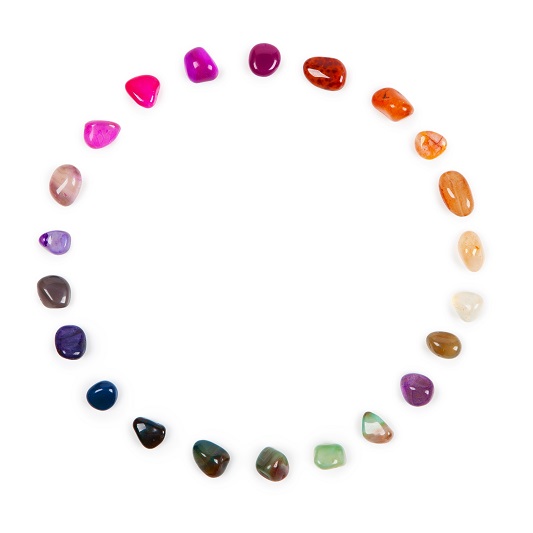Gemstone of the Week: Jasper

LAPADA Art & Antiques Fair – London 15-20 September 2017
15th September 2017
Precious Objects in Fairy Tales and Fables
15th September 2017Deriving from the Greek phrase ‘spotted stone’, Jasper gained its name thanks to the typical striped, flamed, or spotted appearance that the majority of the stones hold. Like many gemstones available today, Jasper is a variety of quartz. To be exact, it is an impure and opaque type of silicon dioxide. Usually, Jasper is considered a chalcedony, due to the fact that the precious stone is known to form in virtually every colour under the sun; however, some scientists beg to differ on this issue, classifying Jasper as a separate type altogether, due to its distinctive grainy structure.
How to Identify Jasper
As mentioned previously Jasper is a specific variety of quartz, made up of mostly silicon dioxide. Often, fine Jasper is made up of other materials, typically consisting of hematite, pyrolusite, clay or calcite. Although it is often referred to as a type of chalcedony, some scientists prefer to class Jasper as a completely separate member of the quartz family, due to how intense the grainy structure of the natural stone is compared to there forms of chalcedony. Boasting a microcrystalline structure, tiny trigonal crystals are present in the stone and can be seen by the naked eye under good quality magnifying equipment. An easy way to distinguish Jasper from other similar stones is by the previously mentioned, distinctive, grainy surface, but also by its hardness and the smoothness of the stone. The mineral comes in many different forms, one particular being referred to as ‘banded’. Banded jasper is sometimes confused with Agate, but an easy way to differentiate between the two is by remembering the Jasper is always opaque, whereas Agate is not. If you find a stone you perceive to be Jasper, but deem that it is lacking interest in the form of its colours or pattern, what you’re holding is more likely to be Chert, rather than Jasper.
Different Colours and Types of Jasper
Up to 20% of natural Jasper is believed to consist of a variety of foreign materials. Occasionally even growing together with agate or opal, Jasper is rarely one colour alone. The creative patterns found on the stone are formed from the process of mineral consolidation, their nature dependent on the flow of different sediments or volcanic ash. After the formation of the stone begins, it is not uncommon for Jasper to be modified by other impurities within the ground. As the stone starts to form, natural cracks will begin to appear which are then naturally filled with other materials; for instance, manganese dioxide, metal oxide and iron oxide, just to name a few. The patterned exterior of the stone is formed when the different layers of material set and harden, determining the final appearance of the substance.
Although all differing in style, the most common patterns to appear on the exterior of Jasper are marbling and veining, rings, streaks, sports, flaming and banding. Like with any stone with multiple styles of appearance, specific names for each kind exist in order to be able to distinguish between them all. Although helpful to some, for the everyday individual, the variation in names can become quite confusing; luckily, the trade names and classifications are only used by avid collectors, most of the time.
In regards to colour, Jasper comes in a wide variety of different tones, hues and shades. For the most part, the colours tend to be striped, spotted or flamed. The colours to accompany the confusing trade names usually seem to fall somewhere in the category of brown, yellow and reddish, but some forms of Jasper can even appear orange, green, and even blue. Although there seems to be no specific colour that is deemed more valuable or sought after than the rest, one of the most popular colours seems to be red, which is caused by traces of iron oxide making its way into the composition of the rock. What really determines the value of the stone is not the specific colour, but rather the saturation of that colour, instead.
Where is Jasper Found?
Although Jasper can be found in various locations worldwide, some of the most common places that the mineral is found are Kazakhstan, Australia, Brazil, Canada, Egypt, India, Indonesia, Madagascar, Mexico, Russia, Uruguay, Venezuela and the USA, including Arizona, Arkansas, California, Idaho, Oregon, Texas and Washington. Formed from the formation of a variety of different substances, it’s technically possible for Jasper to be sourced from almost anywhere.
Healing Properties of Jasper
Jasper is commonly referred to as the “supreme nurturer”. It is believed to provide support in times of stress, in addition to bringing tranquillity and wholeness to one’s life. The stone is also known to provide protection and absorb negative energy, as well as balancing Yin and yang and one’s chi or qi. With the ability to clear electromagnet and environmental pollution, including radiation, Jasper is a popular stone in today’s world. In regards to mental and emotional well-being, Jasper is thought to encourage honesty and provide courage to assertively tackle problems. The stone aids quick-thinking and it helps encourage organisational abilities, in addition to stimulating the imagination and combatting procrastination. In terms of overall physical health, Jasper is commonly thought to provide support during periods of chronic illness and help the body to naturally re-energise.
Summary
Whether you are hoping to wear a beautiful piece of Jasper gemstone jewellery, or you are interested in using the stones healing properties to rebalance the body’s chi, purchase a piece of natural Jasper and reap the benefits. As always, remember that healing crystals should only be used as an additional support for chronic health conditions, alongside health care from a professional GP or doctor.




